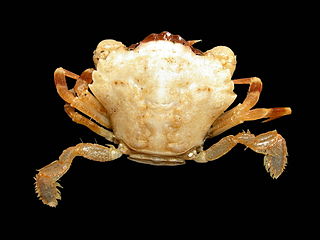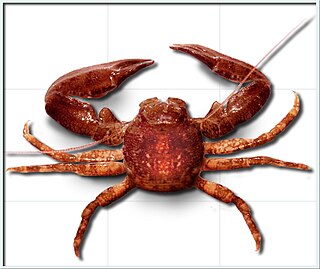Parvulus is a Latin adjective meaning small. It may refer to:

Liocarcinus marmoreus, sometimes known as the marbled swimming crab, is a species of crab found in the northern Atlantic Ocean and North Sea. It may be found on sand and gravel in the sublittoral and lower littoral zones, down to a depth of 84 metres (276 ft), from the Azores and the Alboran Sea as far north as the Shetland Islands. It reaches a carapace length of 35 millimetres (1.4 in), and is distinguished from other similar species by the presence of three similarly sized teeth on the edge of the carapace, between the eyes, and by the marbled colouration on the carapace. L. marmoreus is sometimes parasitised by the barnacle Sacculina.

Latreilliidae is a small family of crabs. They are relatively small, long-legged crabs found on soft bottoms at depths of up 700 metres (2,300 ft) in mostly tropical and subtemperate waters around the world. Their carapace is very small and doesn’t cover the bases of their legs, which protrude from the cephalothorax in a spider-like manner. The family and its type genus are named after Pierre André Latreille. The oldest known fossils from the Latreillidae have been dated to the middle of the Cretaceous period. It comprises seven extant species.

Liocarcinus depurator, sometimes called the harbour crab or sandy swimming crab, is a species of crab found in the North Sea, Atlantic Ocean, Mediterranean Sea, and Black Sea. It grows up to 50 millimetres (2.0 in) in width and 40 mm (1.6 in) long, and can be distinguished from other crabs, such as the shore crab Carcinus maenas, by the curved rows of white spots on its carapace.

Pilumnus hirtellus, the bristly crab or hairy crab, is a species of European crab. It is less than 1 inch (25 mm) long and covered in hair. It lives in shallow water and feeds on carrion.

Liocarcinus navigator is a species of crab in the family Portunidae.

Liocarcinus pusillus, common name dwarf swimming crab, is a species of crab in the Portunidae family.

Pisidia longicornis, the long-clawed porcelain crab, is a species of porcelain crab that lives in the north-eastern Atlantic Ocean. It varies from reddish to white, and grows to a carapace width of 1 cm (0.4 in). It was first named by Carl Linnaeus in 1767, although the etymology remains unclear.

Xantho hydrophilus, the furrowed crab or Montagu's crab, is a species of crab from the family Xanthidae. It is yellowish-brown and grows to a carapace width of 70 mm (2.8 in). It is a nocturnal omnivore that lives in shallow marine waters from western Scotland to the Cape Verde Islands.

Laurentaeglyphea neocaledonica is a species of glypheoid lobster, and the only species in the genus Laurentaeglyphea. It is known from a single specimen collected on a guyot in the Coral Sea between Australia and New Caledonia. It is thought to be an active predator with colour vision, unlike its nearest living relative, Neoglyphea inopinata.

Dyspanopeus sayi is a species of mud crab that is native to the Atlantic coast of North America. It has also become established outside its native range, living in Swansea Docks since 1960, the Mediterranean Sea since the 1970s, the North Sea since 2007 and the Black Sea since 2010. It can reach a carapace width of 20 mm (0.8 in), and has black tips to its unequal claws. It feeds on bivalves and barnacles, and is in turn eaten by predators including the Atlantic blue crab, Callinectes sapidus. Eggs are produced from spring to autumn, the offspring reach sexual maturity the following summer, and individuals can live for up to two years. The closest relative of D. sayi is D. texanus, which lives in the Gulf of Mexico; the two species differ in subtle features of the genitalia and the last pair of walking legs.

Around 65 species of crab occur in the waters of the British Isles. All are marine, with the exception of the introduced Chinese mitten crab, Eriocheir sinensis, which occurs in fresh and brackish water. They range in size from the deep-water species Paromola cuvieri, which can reach a claw span of 1.2 metres, to the pea crab, which is only 4 mm (0.16 in) wide and lives inside mussel shells.

Planes minutus is a species of pelagic crab that lives in the North Atlantic Ocean. It is typically less than 10 mm (0.4 in) long across the back, and is variable in colouration, to match its background. It may have been the crab seen by Christopher Columbus on Sargassum weed in the Sargasso Sea in 1492.

Geryon trispinosus is a species of crab that lives in deep water in the north-eastern Atlantic Ocean.

Albunea carabus is a rare species of "sand crab" or "mole crab" in the family Albuneidae. It lives in shallow, turbulent waters in sandy areas of the tropical eastern Atlantic Ocean and the Mediterranean Sea.
Brachynotus sexdentatus is a species of crab in the family Varunidae. It is native to the Mediterranean Sea and Black Sea, and became established for a time in Swansea Docks. It grows to a maximum carapace width of 18 mm (0.71 in), and lives in shallow water on muddy bottoms.

Portunus sayi, the sargassum swimming crab, is a species of pelagic crab in the family Portunidae. It is found in the western Atlantic Ocean and the Caribbean Sea where it makes its home among floating mats of Sargassum seaweed. It was named in honour of the American naturalist Thomas Say.

Latreillia elegans is a species of crab belonging to the family Latreilliidae. This family of crabs is identified by their appearance as small, long-legged crabs. The species belongs to the genus Latreillia which has only five identified species: L. elegans, L. metanesa, L. williamsi, L.valida, and L. pennifera. It was previously thought that L. elegans and L. mannengi were two separate species, but it has since been revealed that the two species are synonymous. All the thought to be differences between L. elegans and L. mannengi were in actuality overlaps. The L. mannengi is simply referring to the close relative to the species of L. elegans found in the western Atlantic.

Portunus armatus is a species of crustacean, a swimming crab in the family Portunidae found in Australia and eastwards to New Caledonia. Common names include blue swimmer crabs, Blue manna, Blueys, and Jennies. The species was originally considered as a geographic variation of Portunus pelagicus, however in 2010 the Portunus pelagicus species was reviewed using DNA, as well as physical characteristics including measurements and four species recognised: Portunus pelagicus, Portunus armatus, Portunus reticulatis and Portunus segnis. The range of Portunus armatus overlaps with Portunus pelagicus in the Northern Territory of Australia.
















